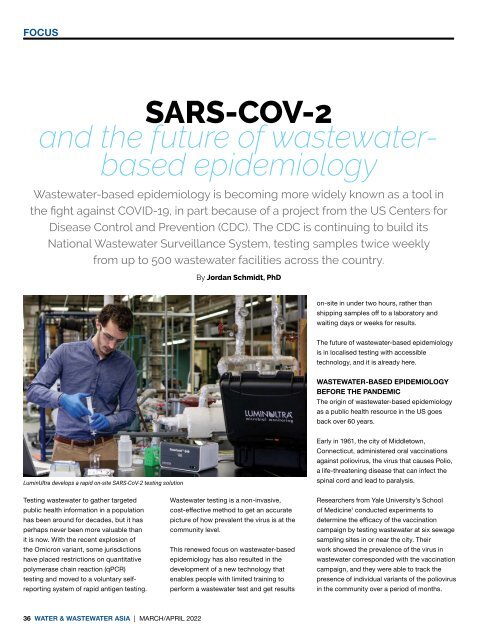Water & Wastewater Asia March/April 2022
Water & Wastewater Asia is an expert source of industry information, cementing its position as an indispensable tool for trade professionals in the water and wastewater industry. As the most reliable publication in the region, industry experts turn this premium journal for credible journalism and exclusive insight provided by fellow industry professionals. Water & Wastewater Asia incorporates the official newsletter of the Singapore Water Association (SWA).
Water & Wastewater Asia is an expert source of industry information, cementing its position as an indispensable tool for trade professionals in the water and wastewater industry. As the most reliable publication in the region, industry experts turn this premium journal for credible journalism and exclusive insight provided by fellow industry professionals. Water & Wastewater Asia incorporates the official newsletter of the Singapore Water Association (SWA).
Create successful ePaper yourself
Turn your PDF publications into a flip-book with our unique Google optimized e-Paper software.
FOCUS<br />
SARS-COV-2<br />
and the future of wastewaterbased<br />
epidemiology<br />
<strong>Wastewater</strong>-based epidemiology is becoming more widely known as a tool in<br />
the fight against COVID-19, in part because of a project from the US Centers for<br />
Disease Control and Prevention (CDC). The CDC is continuing to build its<br />
National <strong>Wastewater</strong> Surveillance System, testing samples twice weekly<br />
from up to 500 wastewater facilities across the country.<br />
By Jordan Schmidt, PhD<br />
on-site in under two hours, rather than<br />
shipping samples off to a laboratory and<br />
waiting days or weeks for results.<br />
The future of wastewater-based epidemiology<br />
is in localised testing with accessible<br />
technology, and it is already here.<br />
WASTEWATER-BASED EPIDEMIOLOGY<br />
BEFORE THE PANDEMIC<br />
The origin of wastewater-based epidemiology<br />
as a public health resource in the US goes<br />
back over 60 years.<br />
LuminUltra develops a rapid on-site SARS-CoV-2 testing solution<br />
Early in 1961, the city of Middletown,<br />
Connecticut, administered oral vaccinations<br />
against poliovirus, the virus that causes Polio,<br />
a life-threatening disease that can infect the<br />
spinal cord and lead to paralysis.<br />
Testing wastewater to gather targeted<br />
public health information in a population<br />
has been around for decades, but it has<br />
perhaps never been more valuable than<br />
it is now. With the recent explosion of<br />
the Omicron variant, some jurisdictions<br />
have placed restrictions on quantitative<br />
polymerase chain reaction (qPCR)<br />
testing and moved to a voluntary selfreporting<br />
system of rapid antigen testing.<br />
<strong>Wastewater</strong> testing is a non-invasive,<br />
cost-effective method to get an accurate<br />
picture of how prevalent the virus is at the<br />
community level.<br />
This renewed focus on wastewater-based<br />
epidemiology has also resulted in the<br />
development of a new technology that<br />
enables people with limited training to<br />
perform a wastewater test and get results<br />
Researchers from Yale University’s School<br />
of Medicine 1 conducted experiments to<br />
determine the efficacy of the vaccination<br />
campaign by testing wastewater at six sewage<br />
sampling sites in or near the city. Their<br />
work showed the prevalence of the virus in<br />
wastewater corresponded with the vaccination<br />
campaign, and they were able to track the<br />
presence of individual variants of the poliovirus<br />
in the community over a period of months.<br />
36 WATER & WASTEWATER ASIA | MARCH/APRIL <strong>2022</strong>


















